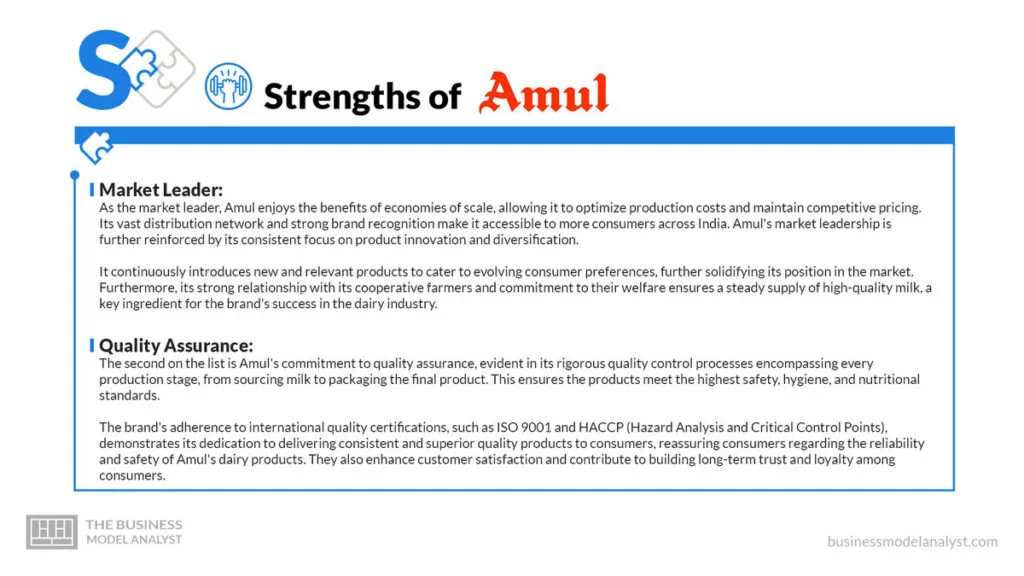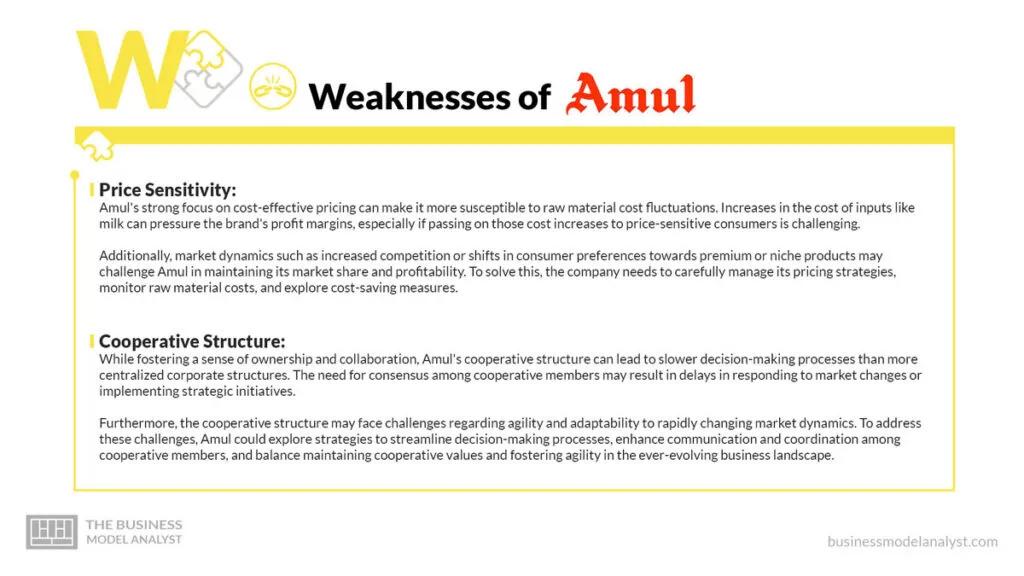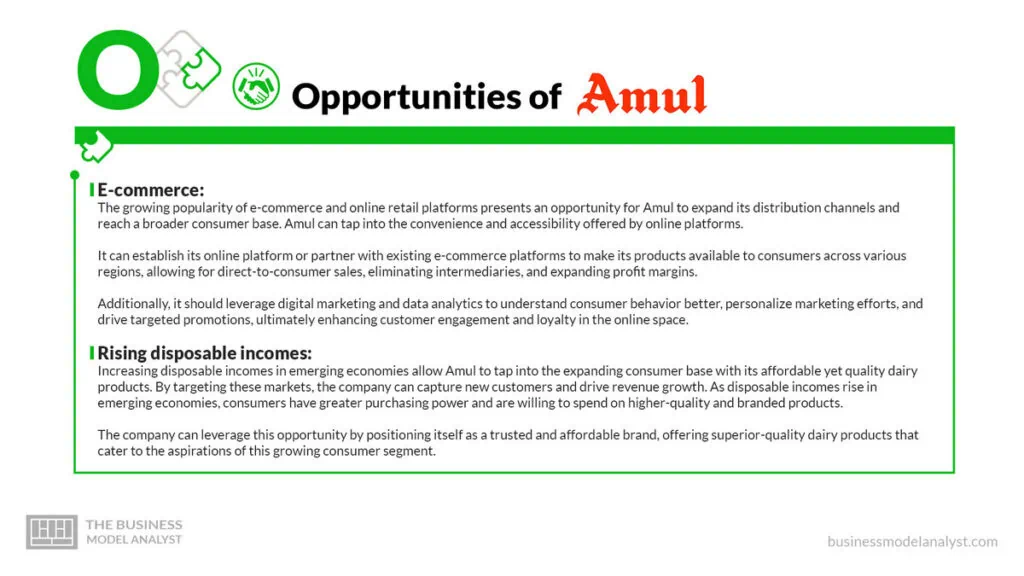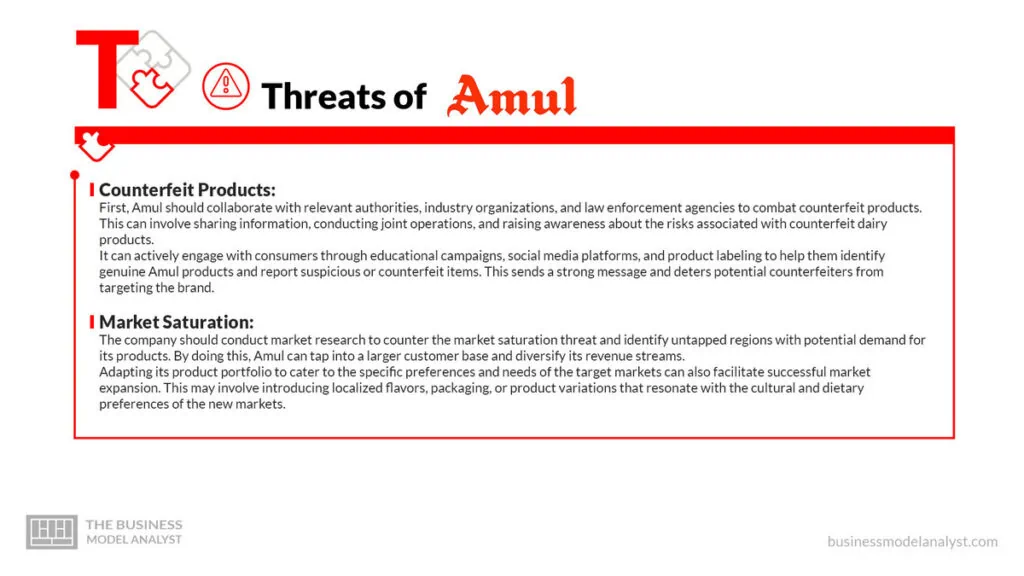Amul, also known as the Gujarat Cooperative Milk Marketing Federation (GCMMF), is an Indian dairy cooperative that has become a household name in India and beyond. Founded in 1946 by Tribhuvandas Patel, Amul has grown to become the largest dairy cooperative in India and one of the most successful brands in the country.
It started as a small cooperative in Gujarat to empower local farmers and provide them with a platform to market their milk and milk products. Today, it has expanded its operations to over 18,700 villages nationwide, with a network of over 3.6 million milk producers.
The company has become synonymous with quality and affordability with a wide range of products, including milk, butter, cheese, ice cream, and more. It has successfully captured the Indian market and made its mark globally, exporting its products to over 60 countries.
Its success can be attributed to its innovative marketing campaigns featuring the iconic Amul girl, a cheerful cartoon character known for her witty and timely comments on current events. These campaigns have helped build brand loyalty and become integral to India’s popular culture.
While Amul has seen tremendous success, it has faced its fair share of challenges. However, it has consistently adapted and innovated to stay ahead. With over 30,000 employees, Amul continues to uphold its core values of integrity, quality, and sustainability. Its commitment to empowering farmers, providing nutritious products, and contributing to the development of rural India has made Amul a remarkable brand in the dairy industry.
Below, there is a detailed Amul SWOT Analysis to better understand its strengths, weaknesses, opportunities, and threats in the global market.
Contents
Amul Strengths

Below, there are some of the reasons Amul is an industry leader in the global market:
Market Leader
As the market leader, Amul enjoys the benefits of economies of scale, allowing it to optimize production costs and maintain competitive pricing. Its vast distribution network and strong brand recognition make it accessible to more consumers across India. Amul’s market leadership is further reinforced by its consistent focus on product innovation and diversification.
It continuously introduces new and relevant products to cater to evolving consumer preferences, further solidifying its position in the market. Furthermore, its strong relationship with its cooperative farmers and commitment to their welfare ensures a steady supply of high-quality milk, a key ingredient for the brand’s success in the dairy industry.
Quality Assurance
The second on the list is Amul’s commitment to quality assurance, evident in its rigorous quality control processes encompassing every production stage, from sourcing milk to packaging the final product. This ensures the products meet the highest safety, hygiene, and nutritional standards.
The brand’s adherence to international quality certifications, such as ISO 9001 and HACCP (Hazard Analysis and Critical Control Points), demonstrates its dedication to delivering consistent and superior quality products to consumers, reassuring consumers regarding the reliability and safety of Amul’s dairy products. They also enhance customer satisfaction and contribute to building long-term trust and loyalty among consumers.
Diverse Product Range
With a diverse product range, Amul can cater to consumers’ tastes and preferences. Whether someone is looking for basic dairy essentials like milk and butter or indulgent treats like ice cream and cheese, it has something to offer for everyone.
This builds customer loyalty, as consumers can rely on the brand for their dairy needs across different categories. It also helps Amul penetrate different market segments and reach a larger consumer base. Its ability to consistently deliver high-quality products across its diverse range further enhances its reputation and strengthens its position in the market.
Cooperative Structure
Amul’s cooperative structure has fostered a strong sense of community and collaboration among the farmers involved. Farmers can pool their resources, share knowledge, and collectively negotiate better prices and terms, ensuring economic well-being. This cooperative model also empowers farmers by giving them a direct stake in the business and decision-making processes, leading to a more sustainable and inclusive dairy industry.
Amul’s cooperative structure also benefits the farmers and promotes rural development. It provides a platform for farmers to sell their milk and earn a fair income. In turn, Amul contributes to rural communities’ economic growth and upliftment, improving their quality of life.
Wide Distribution Network
Amul’s vast distribution network is a key strength that sets it apart in the dairy industry. By reaching over 18,700 villages across India, Amul ensures its products are easily accessible to consumers even in remote areas, fostering inclusivity and catering to a broad customer base. This enables timely delivery and provides the freshness of its dairy products, further strengthening trust among consumers and enhancing Amul’s market position and customer loyalty.
Its ability to maintain a strong presence in rural and urban areas gives it a competitive edge, allowing the brand to tap into the vast consumer market in India, capture consumers’ diverse preferences and demands of consumers from different regions, and contribute to its market leadership.
Strong Supplier Relationships
Amul’s strong supplier relationships with farmers are a cornerstone of its success in the dairy industry. The company has fostered long-term partnerships based on trust, transparency, and fair business practices, creating a mutually beneficial ecosystem.
By working closely with farmers, Amul maintains a reliable and consistent supply of high-quality milk, essential for its diverse range of dairy products. This collaborative approach also allows Amul to support and uplift farmers’ livelihoods actively, promoting their economic well-being and fostering sustainability in the dairy sector.
Cost-effective pricing strategy
Another key strength is its cost-effective pricing strategy, instrumental in capturing a significant market share in the Indian dairy industry. By offering value-for-money products, Amul ensures that its dairy products are accessible and affordable to a wide range of consumers, including those with price-sensitive preferences.
Its competitive pricing attracts price-conscious consumers and creates a competitive advantage over rivals, allowing Amul to penetrate the market and maintain a strong foothold. Its ability to provide quality products at competitive prices reinforces its position as a preferred choice among consumers, contributing to its continued success and market leadership.
Commitment to Social Responsibility
Beyond business operations, Amul is committed to social responsibility. It actively engages in initiatives to improve the well-being of the communities it serves. Through programs focused on rural healthcare, education, and skill development, it strives to uplift the quality of life in rural areas and create opportunities for sustainable growth.
Amul also fosters goodwill and positive brand perception among consumers by actively participating in social responsibility initiatives. This aligns with the values of socially conscious consumers and strengthens the brand’s reputation as a responsible and caring organization.
Strong Brand Identity
The company’s strong brand identity is a testament to its consistently delivering quality products at affordable prices. It has successfully built a reputation for reliability and trustworthiness, earning the loyalty of millions of consumers across India.
Its widespread recognition and popularity have made it a household name, deeply embedded in the country’s cultural fabric. The brand’s iconic logo and memorable advertising campaigns have further contributed to its strong brand identity, creating a lasting impression in the minds of consumers.
Innovative marketing strategies
More than ever, Amul constantly innovates its marketing strategy. The iconic Amul girl, a beloved cartoon character, has become a hallmark of the brand’s marketing approach in its advertisements. Her witty and timely commentary on current events and popular culture has entertained consumers and created a strong emotional connection.
These creative and often humorous campaigns have effectively resonated with the target audience, increasing brand recall and engagement. Amul’s ability to consistently deliver fresh and engaging marketing content has set it apart from its competitors, allowing the brand to maintain a strong and enduring relationship with its consumers.
Amul Weaknesses

Despite its numerous successes, here are some weaknesses that Amul needs to work on:
Price Sensitivity
Amul’s strong focus on cost-effective pricing can make it more susceptible to raw material cost fluctuations. Increases in the cost of inputs like milk can pressure the brand’s profit margins, especially if passing on those cost increases to price-sensitive consumers is challenging.
Additionally, market dynamics such as increased competition or shifts in consumer preferences towards premium or niche products may challenge Amul in maintaining its market share and profitability. To solve this, the company needs to carefully manage its pricing strategies, monitor raw material costs, and explore cost-saving measures.
Cooperative Structure
While fostering a sense of ownership and collaboration, Amul’s cooperative structure can lead to slower decision-making processes than more centralized corporate structures. The need for consensus among cooperative members may result in delays in responding to market changes or implementing strategic initiatives.
Furthermore, the cooperative structure may face challenges regarding agility and adaptability to rapidly changing market dynamics. To address these challenges, Amul could explore strategies to streamline decision-making processes, enhance communication and coordination among cooperative members, and balance maintaining cooperative values and fostering agility in the ever-evolving business landscape.
Brand Perception outside Dairy
The company’s strong brand perception as a dairy specialist makes it more challenging to establish credibility and recognition in non-dairy food segments. Consumers may perceive Amul as primarily focused on dairy, potentially limiting their willingness to try or accept non-dairy products from the brand.
As such, Amul needs to build brand awareness and consumer trust to venture into non-dairy segments successfully. It could consider strategic partnerships, acquisitions, or brand extensions to enter non-dairy food segments while leveraging its existing brand equity to mitigate this limitation.
Inadequate Infrastructure
In regions with inadequate infrastructure and cold chain logistics, Amul may face challenges in ensuring the freshness and quality of its perishable dairy products during transportation and storage. Inconsistent or suboptimal infrastructure can lead to issues such as temperature fluctuations, product spoilage, and delivery delays, negatively impacting customer satisfaction.
Addressing infrastructure challenges requires investments in building and maintaining a robust cold chain network, including refrigerated storage facilities, transportation systems, and last-mile delivery capabilities. Collaborating with logistics partners and investing in technology and monitoring systems can help Amul ensure the integrity of its products throughout the distribution process and mitigate potential infrastructure-related issues.
Intense Competition
The intense competition in the Indian dairy industry pressures Amul to continuously innovate, differentiate its offerings, and stay ahead of competitors. Rival brands may introduce similar products, competitive pricing strategies, or aggressive marketing campaigns, which could challenge Amul’s market share and profitability.
Amul must consistently deliver high-quality products, leverage its strong brand reputation, and actively monitor market trends to anticipate and respond to competitive challenges to maintain its competitive edge. It should implement effective marketing and branding strategies, enhance product diversification, and focus on customer loyalty to withstand the competition and retain its market leadership.
Limited International Presence
Although Amul has a presence in over 18,000 villages, it needs to strengthen its international presence further. If not, this will hinder its ability to tap into the full potential of global markets and capitalize on the growing demand for dairy products worldwide. Competing with established international dairy brands that have a wider reach and stronger market presence could pose challenges for Amul’s expansion and market share growth on a global scale.
To overcome this weakness, Amul can focus on strategic international expansion plans, exploring new markets, establishing strong distribution networks, and adapting its products and marketing strategies to cater to the preferences and demands of global consumers.
Amul Opportunities

Here are some of the opportunities that Amul can take advantage of:
E-commerce
The growing popularity of e-commerce and online retail platforms presents an opportunity for Amul to expand its distribution channels and reach a broader consumer base. Amul can tap into the convenience and accessibility offered by online platforms.
It can establish its online platform or partner with existing e-commerce platforms to make its products available to consumers across various regions, allowing for direct-to-consumer sales, eliminating intermediaries, and expanding profit margins.
Additionally, it should leverage digital marketing and data analytics to understand consumer behavior better, personalize marketing efforts, and drive targeted promotions, ultimately enhancing customer engagement and loyalty in the online space.
Rising disposable incomes
Increasing disposable incomes in emerging economies allow Amul to tap into the expanding consumer base with its affordable yet quality dairy products. By targeting these markets, the company can capture new customers and drive revenue growth. As disposable incomes rise in emerging economies, consumers have greater purchasing power and are willing to spend on higher-quality and branded products.
The company can leverage this opportunity by positioning itself as a trusted and affordable brand, offering superior-quality dairy products that cater to the aspirations of this growing consumer segment.
Innovation in product offerings
Amul can leverage consumer insights and market research to identify emerging trends and develop products that align with evolving preferences. For example, introducing dairy products with natural or organic ingredients can appeal to health-conscious consumers seeking clean-label options.
Packaging innovations, such as portion-controlled or on-the-go formats, can provide convenience and cater to busy lifestyles. Additionally, creating value-added products like fortified milk with added nutrients or probiotics can address specific dietary needs and offer enhanced nutritional benefits to consumers.
Health and Wellness Trends
More so, Amul can capitalize on the health and wellness trend by expanding its range of healthier dairy products. This includes developing low-fat or reduced-sugar options that cater to consumers looking for healthier alternatives. It can explore the growing demand for plant-based dairy alternatives, such as almond milk or soy-based products, to cater to the increasing number of consumers adopting a vegan or lactose-intolerant lifestyle.
Furthermore, fortifying dairy products with essential vitamins, minerals, or probiotics can offer health benefits and appeal to health-conscious consumers. This way, it positions itself as a trusted brand for those seeking nutritious and wholesome dairy options.
Partnerships and Collaborations
Strategic partnerships and collaborations with international dairy brands are key to expanding its global reach and entering new markets. This helps Amul gain access to new customer bases and distribution channels.
Collaborating with retailers and distributors domestically and internationally can also help the company enhance its market penetration and increase product visibility. Such partnerships can enable Amul to reach a wider range of consumers and establish a stronger foothold in various regions. Furthermore, technology collaborations with dairy industry players can facilitate knowledge sharing, innovation, and process improvements.
Sustainable Certifications
To minimize its environmental footprint and contribute to a more sustainable dairy industry, Amul can invest in sustainable farming practices, such as organic farming, efficient water management, and renewable energy adoption.
Promoting animal welfare through ethical treatment and responsible sourcing can resonate with consumers prioritizing animal rights and welfare. Obtaining certifications like Fairtrade, organic, or sustainable agriculture certifications can provide tangible evidence of Amul’s commitment to sustainability and ethical practices.
Amul Threats

While Amul has done well for itself in the dairy sector, below, there are threats that it needs to pay attention to and tackle:
Counterfeit Products
First, Amul should collaborate with relevant authorities, industry organizations, and law enforcement agencies to combat counterfeit products. This can involve sharing information, conducting joint operations, and raising awareness about the risks associated with counterfeit dairy products.
It can actively engage with consumers through educational campaigns, social media platforms, and product labeling to help them identify genuine Amul products and report suspicious or counterfeit items. This sends a strong message and deters potential counterfeiters from targeting the brand.
Market Saturation
The company should conduct market research to counter the market saturation threat and identify untapped regions with potential demand for its products. By doing this, Amul can tap into a larger customer base and diversify its revenue streams.
Adapting its product portfolio to cater to the specific preferences and needs of the target markets can also facilitate successful market expansion. This may involve introducing localized flavors, packaging, or product variations that resonate with the cultural and dietary preferences of the new markets.
Supply Chain Disruptions
Amul should diversify its supplier base and establish strong relationships with multiple suppliers to minimize the risk of disruptions, such as conducting thorough due diligence on suppliers, implementing contingency plans, and regularly reviewing and monitoring supplier performance.
Investing in technology and systems that enhance supply chain visibility and traceability can help Amul identify and address potential bottlenecks or disruptions in real time. Furthermore, collaborating with logistics partners and having alternative transportation routes or storage facilities in place can provide flexibility and reduce unexpected disruptions in the supply chain.
Regulatory Challenges
Amul should establish a dedicated regulatory affairs team to stay updated on the evolving regulatory landscape and ensure compliance with relevant laws and standards. This team can monitor changes in food safety regulations, labeling requirements, and environmental regulations and proactively implement necessary adjustments to products, processes, and packaging.
Regular audits and inspections of manufacturing facilities can help identify and address compliance gaps, ensuring the brand maintains high quality and safety standards. Additionally, fostering strong relationships with regulatory authorities and industry associations can provide valuable insights and guidance on navigating complex regulatory challenges.
Negative Consumer perceptions
More than ever, Amul should engage in transparent and open communication with its customers to tackle negative consumer perceptions about dairy. This can involve sharing information about sustainable farming practices, animal welfare initiatives, and efforts to minimize the environmental impact of its operations.
Amul can also invest in sustainability initiatives, such as reducing carbon emissions, implementing waste management strategies, and promoting eco-friendly packaging options. This way, Amul can promote the nutritional benefits of dairy products, highlighting their role in a balanced and healthy diet, and address any misconceptions or myths that can help overcome health-related concerns.
Conclusion
In conclusion, Amul has established itself as a leading player in the Indian dairy industry, leveraging its strengths in market leadership, quality assurance, diverse product range, cooperative structure, extensive distribution network, strong supplier relationships, cost-effective pricing, commitment to social responsibility, strong brand identity, and innovative marketing strategies.
While facing specific weaknesses and threats, such as price sensitivity, reliance on a cooperative structure, limited international presence, infrastructure challenges, strong competition, and market saturation, Amul has numerous opportunities to capitalize on, including e-commerce, rising disposable incomes, innovation in product offerings, health and wellness trends, partnerships and collaborations, and sustainable practices.
By addressing these weaknesses and leveraging the opportunities, the company can continue strengthening its market position, expanding its reach, and maintaining its strong brand reputation. This also ensures it is well-positioned to meet the evolving needs of consumers and sustain its growth in the dynamic dairy industry.


